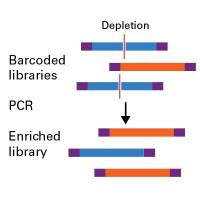Quantification of Gene Transcripts with Deep Sequencing Analysis of Gene Expression (DSAGE) Using 1 to 2 µg Total RNA
互联网
- Abstract
- Table of Contents
- Materials
- Figures
- Literature Cited
Abstract
Deep sequencing analysis of gene expression (DSAGE) measures global gene transcript levels from only 1 to 2 µg total RNA by massively parallel sequencing of cDNA tags. This unit describes the construction of 21?bp cDNA tag libraries appropriate for massively parallel sequencing and analysis of the resulting sequence data. The adapter oligonucleotides used are optimized for sequencing with current Illumina massively parallel sequencers, and a step?by?step implementation of the analysis protocol is described. The expression profiles obtained are highly reproducible, enabling sensitive detection of differences between experimental conditions as well as assessment of the relative transcript abundance of different genes. Curr. Protoc. Mol. Biol. 93:25B.9.1?25B.9.16. © 2011 by John Wiley & Sons, Inc.
Keywords: digital gene expression; serial analysis of gene expression (SAGE); gene expression profiling; high?throughput sequencing
Table of Contents
- Introduction
- Basic Protocol 1: DSAGE Library Construction
- Basic Protocol 2: Generation and Comparison of Gene Expression Profiles
- Alternate Protocol 1: Automated Generation of Expression Profiles for Multiple Samples
- Support Protocol 1: Generation of Gene‐Based Annotation Tables from Expanded Transcript Tables
- Reagents and Solutions
- Commentary
- Literature Cited
- Figures
- Tables
Materials
Basic Protocol 1: DSAGE Library Construction
Materials
Basic Protocol 2: Generation and Comparison of Gene Expression Profiles
Materials
|
Figures
-
Figure 25.B0.1 cDNA library construction for DSAGE. mRNA is selected from total RNA using oligo(dT) ferromagnetic beads, and double‐stranded cDNA is synthesized while the mRNA is bound to the beads. cDNA is then cleaved with anchoring enzyme Nla III, leaving a 4‐bp 3′ overhang (CATG), which is ligated to a forward adapter containing an Mme I restriction site. Mme I cuts 20 bp downstream of the non‐palindromic recognition site, generating a 21‐bp unique tag sequence for each mRNA transcript. Finally, the reverse adapter containing a 2‐bp 3′ degenerate overhang is ligated. View Image -
Figure 25.B0.2 Library excision from a polyacrylamide gel. The 66‐bp pre‐PCR library (A ) and the final amplified 88‐bp library (B ) are shown. View Image -
Figure 25.B0.3 Data analysis pipeline. Sequenced tags in the FASTQ file are aligned to the genome and transcriptome. Gene expression profiles are generated by tallying the aligned tags for each gene. The resulting expression profiles can be compared to assess fold change and significance in gene expression. View Image -
Figure 25.B0.4 Tags aligned to the Nkx2‐5 locus from mouse left ventricle. Nkx2‐5 has three Nla III sites found in the first exon (denoted by an asterisk). The majority of the sequence tags were aligned to the most 3′ Nla III site, indicating that digestion with Nla III was nearly complete. View Image
Videos
Literature Cited
| Literature Cited | |
| Audic, S. and Claverie, J.M. 1997. The significance of digital gene expression profiles. Genome Res. 7:986‐995. | |
| Bentley, D.R., Balasubramanian, S., Swerdlow, H.P., Smith, G.P., Milton, J., Brown, C.G., et al. 2008. Accurate whole human genome sequencing using reversible terminator chemistry. Nature 456:53‐59. | |
| Draghici, S., Khatri, P., Eklund, A.C., and Szallasi, Z. 2006. Reliability and reproducibility issues in DNA microarray measurements. Trends Genet. 22:101‐109. | |
| Karolchik, D., Hinrichs, A.S., Furey, T.S., Roskin, K.M., Sugnet, C.W., Haussler, D., and Kent, W.J. 2004. The UCSC Table Browser data retrieval tool. Nucleic Acids Res. 32:D493‐D496. | |
| Kent, W.J., Sugnet, C.W., Furey, T.S., Roskin, K.M., Pringle, T.H., Zahler, A.M., and Haussler, D. 2002. The human genome browser at UCSC. Genome Res. 12:996‐1006. | |
| Kim, J.B., Porreca, G.J., Song, L., Greenway, S.C., Gorham, J.M., Church, G.M., Seidman, C.E., and Seidman, J.G. 2007. Polony multiplex analysis of gene expression (PMAGE) in mouse hypertrophic cardiomyopathy. Science 316:1481‐1484. | |
| Langmead, B., Trapnell, C., Pop, M., and Salzberg, S.L. 2009. Ultrafast and memory‐efficient alignment of short DNA sequences to the human genome. Genome Biol. 10:R25. | |
| Li, H., Handsaker, B., Wysoker, A., Fennell, T., Ruan, J., Homer, N., Marth, G., Abecasis, G., Durbin, R.; 1000 Genome Project Data Processing Subgroup. 2009. The Sequence Alignment/Map format and SAMtools. Bioinformatics 25:2078‐2079. | |
| Schroeder, A., Mueller, O., Stocker, S., Salowsky, R., Leiber, M., Gassmann, M., Lightfoot, S., Menzel, W., Granzow, M., and Ragg, T. 2006. The RIN: An RNA integrity number for assigning integrity values to RNA measurements. BMC Mol. Biol. 7:3. | |
| Trapnell, C., Pachter, L., and Salzberg, S.L. 2009. TopHat: Discovering splice junctions with RNA‐Seq. Bioinformatics 25:1105‐1111. | |
| Velculescu, V.E., Zhang, L., Vogelstein, B., and Kinzler, K.W. 1995. Serial analysis of gene expression. Science 270:484‐487. |









